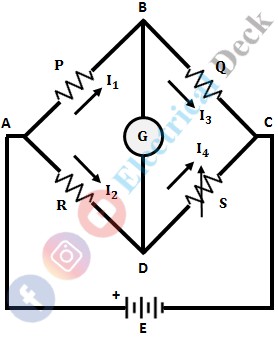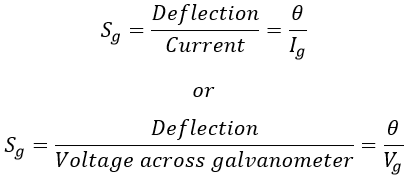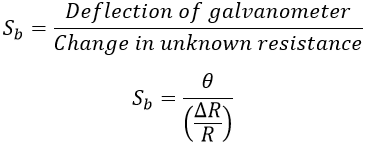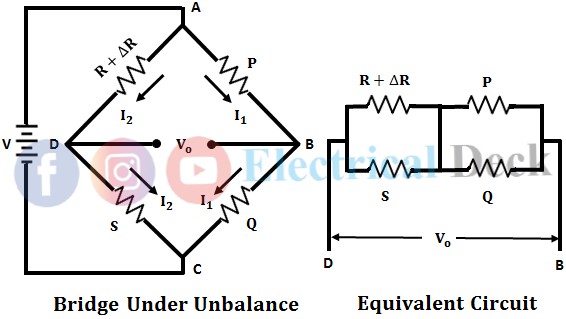Wheatstone bridge is the most common, accurate, and reliable method, used for the measurement of medium resistance. The principle of operation of the Wheatstone bridge is based on the null deflection. It is used to determine unknown resistance by comparing it with the known resistance.
Construction of Wheatstone Bridge :
The below shows the circuit connections of Wheatstone Bridge. It consists of four arms in which four resistances are connected (one in each arm). A source emf and null detector (galvanometer) are connected between points AC and BD respectively.
The arms with resistances R1 and R2 are called ratio arms. The resistance R3 is the standard arm resistance and R4 is the unknown resistance to be measured.
Working of Wheatstone Bridge :
The principle of working of Wheatstone Bridge is on the null deflection or null indication i.e., when the bridge is balanced the ratio of their resistances are equal and no current flows through the galvanometer.
If the bridge is unbalanced there will be a potential difference between B and D, which causes a current to flow through the galvanometer. In order to achieve a balanced condition, the known resistance and variable resistance should be varied. The basic circuit of the Wheatstone bridge is shown below.
let,- P = Resistance of arm AB
- Q = Resistance of BC
- R = Resistance of AD
- S = Resistance of CD
- E = Source (battery)
- G = Galvanometer (detector).
The bridge is said to be balanced, when the potential difference between points A and B is equal to the voltage across points A and D (i.e., the potential difference across the galvanometer or BD is zero). Hence, no current flows through the galvanometer, thus the no deflection in it (null-deflection).
Under balancing condition, the voltage across AB will equal to the voltage across AD i.e.,I1 P = I2 R ...(1)When the bridge is balanced, the following conditions also exist,
Where E is the emf of the source. Substituting the values of I1 and I2 in equation 1, we get,
Where,- R = Unknown resistance
- S = Standard arm resistance
- P, Q = Ratio arms.
The above expression is the equation of the Wheatstone bridge under balanced condition. Hence, from the above equation, the value of unknown resistance R can be determined if the resistances in the other three arms i.e., P, Q, and S are known.
Sensitivity of the Wheatstone Bridge :
At the balance condition, the galvanometer reads zero current. But it deflects for a small unbalance in the bridge i.e., the deflection of the galvanometer depends on its sensitivity, which is given as,
Assume,- θ = Deflection of the galvanometer
- Ig = Current through the galvanometer
- Vg = Voltage across the galvanometer.
Sensitivity of the bridge is defined as the ratio of deflection of the galvanometer to the unit fractional change in the unknown resistance i.e.,
In order to obtain the sensitivity of the bridge, assuming a small unbalance in the bridge i.e., the unbalance ΔR is at resistance R. Due to this unbalance in the bridge, an emf Vo appears across BD i.e., across the galvanometer as shown below.










